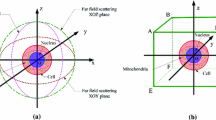Abstract
Ovarian cancer is a very insidious malignant tumor. In order to detect ovarian cancer cells early, the classification and recognition of ovarian cancer cells is mainly studied by two-dimensional light scattering technology. Firstly, a single-cell two-dimensional light scattering pattern acquisition platform based on single-mode optical fiber illumination is designed to collect a certain number of two-dimensional light scattering patterns of ovarian cancer cells and normal ovarian cells. Then, the HOG (Histogram of Oriented Gradient) algorithm is used to extract shaving anisotropy feature of two-dimensional light scattering pattern. The results show that the accuracy of classification and identification of ovarian cancer cells by two-dimensional light scattering technology is 90.81%, which suggests that the specificity of cancer cells and normal cells can be characterized by two-dimensional light scattering technology.





Similar content being viewed by others
References
Halaney, D. L., Zahedivash, A., Phipps, J. E., Wang, T., Dwelle, J., Saux, C. J. L., Asmis, R., Milner, T. E., and Feldman, M. D., Differences in forward angular light scattering distributions between Ml and M2 macrophages[J]. J. Biomed. Opt. 20(11):115002–115002, 2015.
Shahin, H., Gupta, M., Janowska-Wieczorek, A., Rozmus, W., and Tsui, Y. Y., Physical characterization of hematopoietc stem cells using multidirectional label-free light scatterings[J]. Opt. Express 24(25):1094–4087, 2016.
Arifler, D., MacAulay, C., Follen, M., and Guillaud, M., Numerical investigation of two-dimensional light scattering patterns of cervical cell nuclei to map dysplastic changes at different epithelial depths[J]. Biomed. Opt. Express 5(2):485–498, 2014.
Holler, S., Fuerstenau, S. D., and Skelsey, C. R., Simultaneous two-color, two-dimensional angular optical scattering patterns from airborne particulates: Scattering results and exploratory analysis[J]. J. Quant. Spectrosc. Radiat. Transf. 178:167–175, 2016.
Xie, L. Y., Liu, Q., Shao, C. S., and Su, X. T., Differentiation of normal and leukemic cells by 2D light scattering label-free static cytometry[J]. Opt. Express 24(19):21700–21707, 2016.
Su, X. T., Liu, S. S., Qiao, X., Yang, Y., Song, K., and Kong, B. H., Pattern recognition cytometry for label-free cell classification by 2D light scattering measurements[J]. Opt. Express 23(21):27558–27565, 2015.
Fan, X., Zheng, W., and Singh, D. J., Light scattering and surface plasmons on small spherical particles[J]. Light: Science & Applications 3(6):e179, 2014.
Schittny, R., Kadic, M., Bückmann, T. et al., Invisibility cloaking in a diffusive light scattering medium[J]. Science, 2014. https://doi.org/10.1126/science.1254524.
Jo, Y., Jung, J., Lee, J. W., Shin, D., Park, H., Nam, K. T., Fark, J.-H., and Park, Y., Angle-resolved light scattering of individual rod-shaped based on Fourier transform light scattering[J]. Sci. Rep. 4:5090, 2014.
Author information
Authors and Affiliations
Corresponding author
Ethics declarations
Conflict of interest
Author Qi Chen declares that he has no conflict of interest. Author Jianling Zhang declares that he has no conflict of interest.
Ethical approval
All procedures performed in studies involving human participants were in accordance with the ethical standards of the institutional and/or national research committee and with the 1964 Helsinki declaration and its later amendments or comparable ethical standards.
This article does not contain any studies with animals performed by any of the authors.
Informed consent
Informed consent was obtained from all individual participants included in the study.
Additional information
Publisher’s Note
Springer Nature remains neutral with regard to jurisdictional claims in published maps and institutional affiliations.
This article is part of the Topical Collection on Systems-Level Quality Improvement
Rights and permissions
About this article
Cite this article
Chen, Q., Zhang, J. Classification and Recognition of Ovarian Cells Based on Two-Dimensional Light Scattering Technology. J Med Syst 43, 127 (2019). https://doi.org/10.1007/s10916-019-1211-y
Received:
Accepted:
Published:
DOI: https://doi.org/10.1007/s10916-019-1211-y




